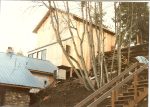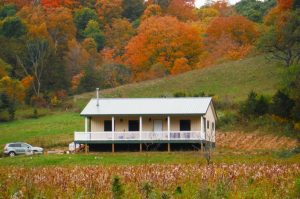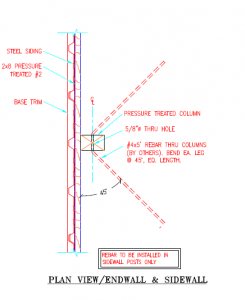Today’s “Ask the Guru” blog answers reader questions about a pole barn being built on a “walk out type” foundation, use of a conventional pier foundation for high clay soils, and if we are able to please build a residential single story “patio room.”
 DEAR POLE BARN GURU: Can a pole barn be built on a walk out type foundation? CRAIG in MESICK
DEAR POLE BARN GURU: Can a pole barn be built on a walk out type foundation? CRAIG in MESICK
DEAR CRAIG: Most certainly, I built my own this way 30 years ago! For some extended reading please visit: https://www.hansenpolebuildings.com/2020/02/barndominium-on-a-daylight-basement/
DEAR POLE BARN GURU: I am about to break ground on very bad clay soil and to make matters worse it is on a moderate slope. Originally, I was going to go with a poured slab in a pole barn, but a couple of contractors have suggested I go with a conventional foundation on piers. My dirt-work guy seems to think it will actually cost less since he won’t be moving all that dirt. I will also have to do one of my porches as a deck rather than concrete. I am working on a squeaky tight budget too. What are your thoughts on this? TAMMY in MONTGOMERY
DEAR TAMMY: Obviously you know clay is about the worst thing you can possibly build on.
 My own barndominium site was very similar, including a slope. We had all of the clay excavated out, down to frost line (not an issue where you are) and then brought in compactible fill to a level point, and poured a slab on grade. Expensive, but correct.
My own barndominium site was very similar, including a slope. We had all of the clay excavated out, down to frost line (not an issue where you are) and then brought in compactible fill to a level point, and poured a slab on grade. Expensive, but correct.
Working on a tight budget, we could engineer for your building to be over a crawl space, using either embedded columns, or columns set using concrete piers and wet set brackets. This would save the cost of pouring a conventional footing and foundation. This would also give you an advantage in being able to live on wood, rather than concrete.
DEAR POLE BARN GURU: Hello. Are you able to please build a residential single story “patio room” of 13′ by 16′? Thinking of these requirements: Windows with full screens on all 3 sidesØ Insulated walls with drywall.Ø 1 Ceiling fanØ At least 4 15 Amp 125-Volt Duplex electrical outletsØ 1 door on the side that leads to a future deck. How does insulation, drywall and electricity work for something like this? Thank you. ERIC in OCONOMOWOC
 DEAR ERIC: It can certainly be done. Walls will need to have at least some ‘solid’ areas in order to properly transfer wind shear loads. Needed amount would depend upon height of building. Walls should be bookshelf girted to create an insulation cavity (and a place to run electrical) without a need to add more framing in order to side and finish interior. Electrical would be no different than for any structural system and would need to tie back into your home’s main breaker box. Use an omnidirectional Water Resistant Barrier between siding and framing, Rockwool batt insulation to fill wall cavities, a well-sealed interior vapor barrier, then gypsum wallboard (drywall).
DEAR ERIC: It can certainly be done. Walls will need to have at least some ‘solid’ areas in order to properly transfer wind shear loads. Needed amount would depend upon height of building. Walls should be bookshelf girted to create an insulation cavity (and a place to run electrical) without a need to add more framing in order to side and finish interior. Electrical would be no different than for any structural system and would need to tie back into your home’s main breaker box. Use an omnidirectional Water Resistant Barrier between siding and framing, Rockwool batt insulation to fill wall cavities, a well-sealed interior vapor barrier, then gypsum wallboard (drywall).
 A single post can be both constrained or non-constrained, depending on the load case. Using the previous example of a concrete slab-on-grade, and assuming that the post is not attached to the slab, if the wind loading was such that the post was pushing on the slab, the post would be considered constrained. However, if the wind were blowing in the opposite direction, the post would not be supported by the slab; hence, the post would be analyzed for that load case as non-constrained.”
A single post can be both constrained or non-constrained, depending on the load case. Using the previous example of a concrete slab-on-grade, and assuming that the post is not attached to the slab, if the wind loading was such that the post was pushing on the slab, the post would be considered constrained. However, if the wind were blowing in the opposite direction, the post would not be supported by the slab; hence, the post would be analyzed for that load case as non-constrained.”





